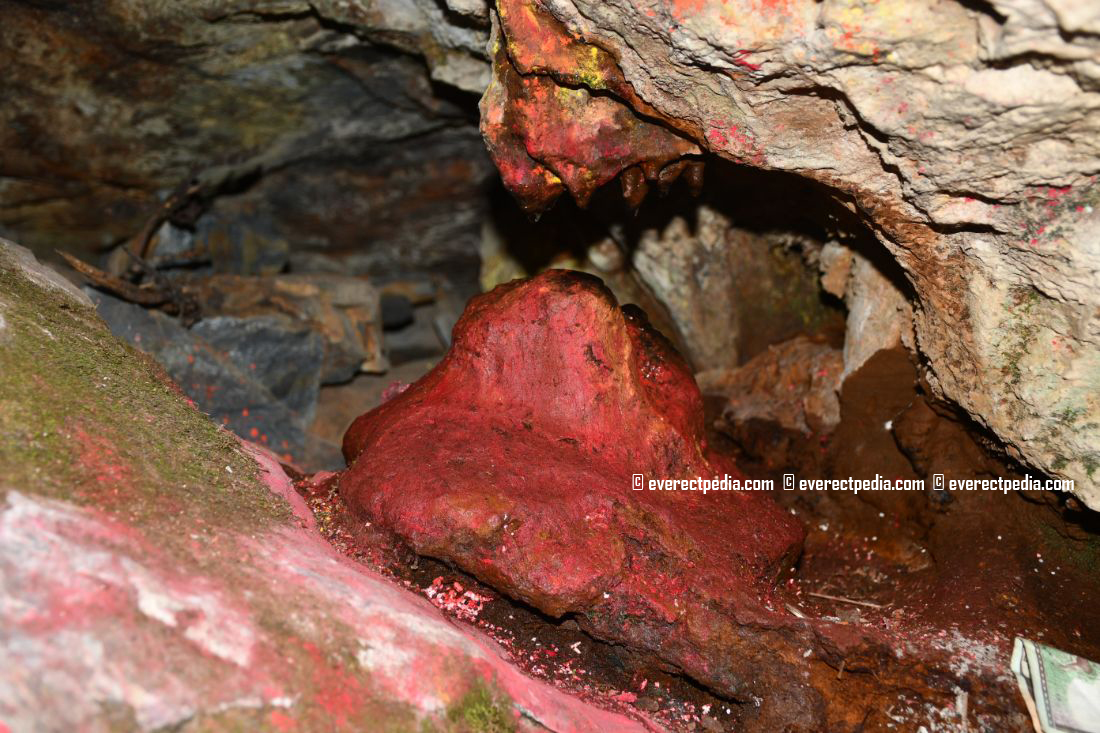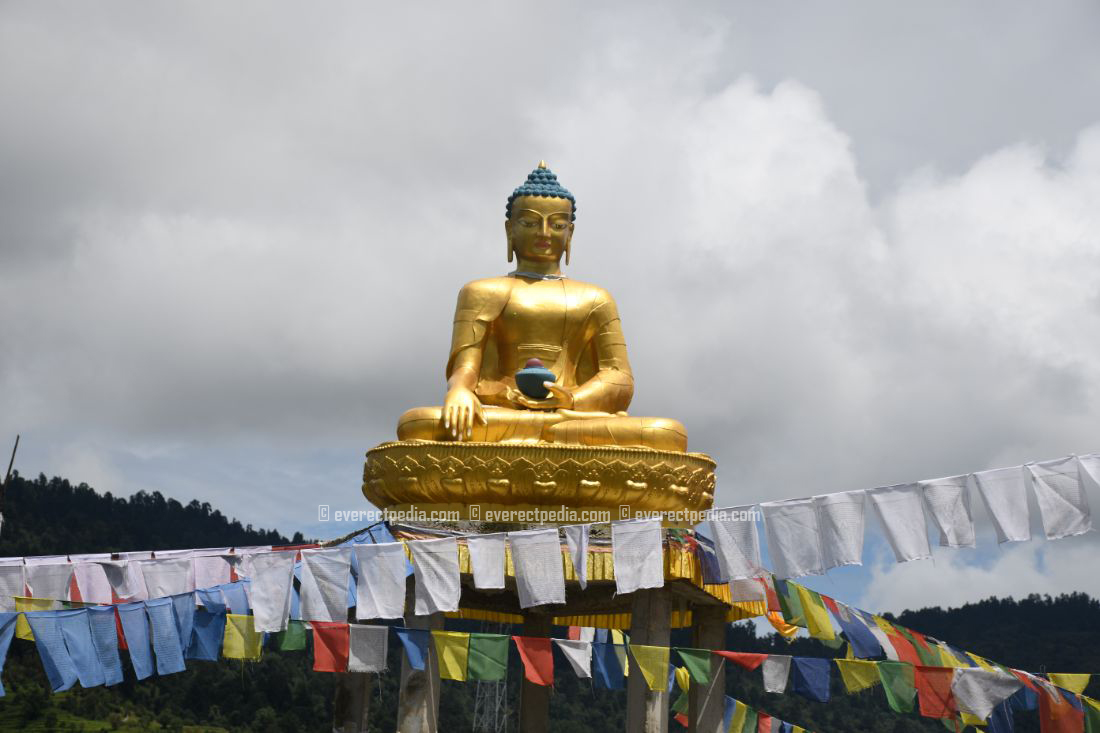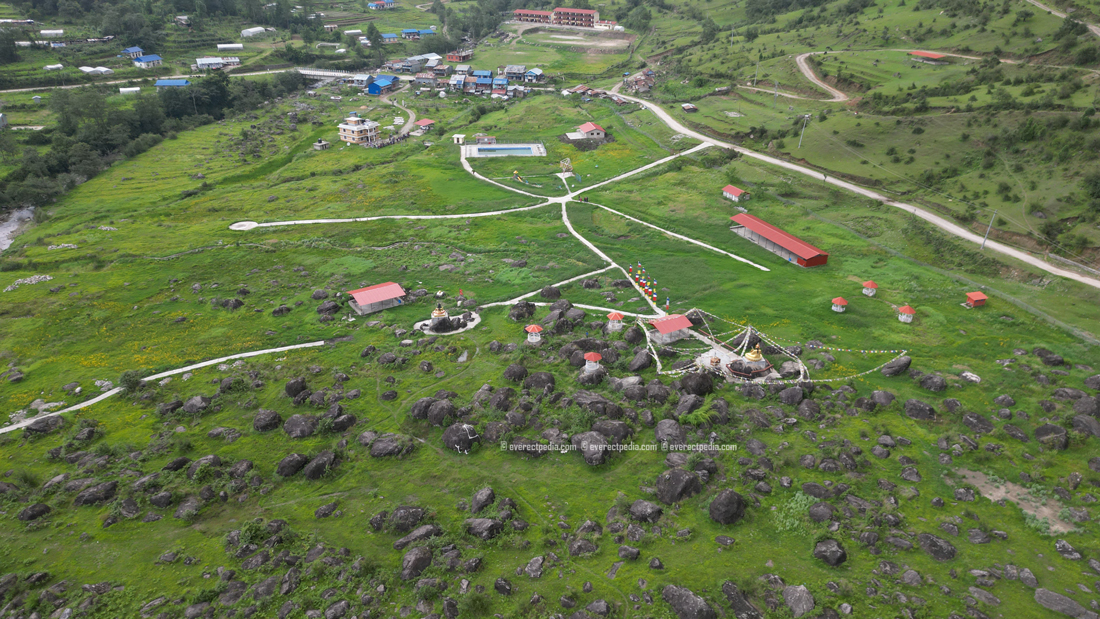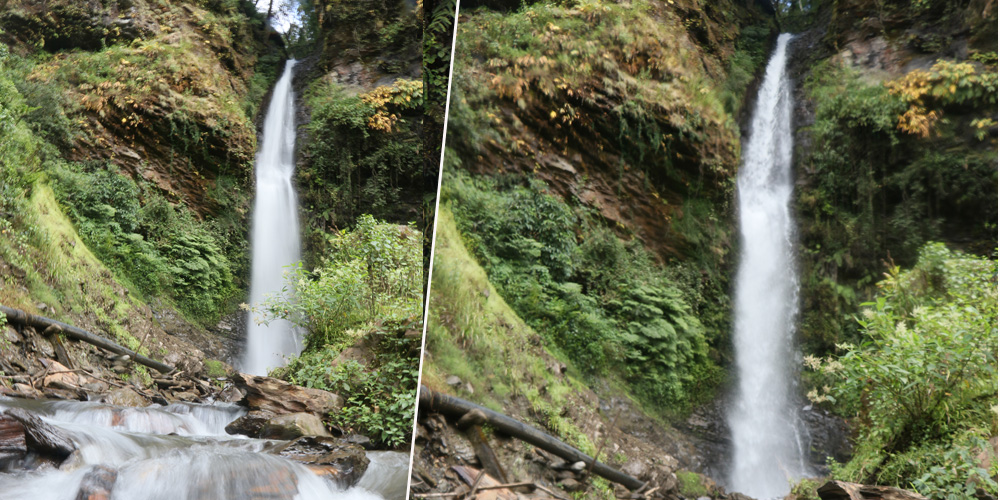Kathmandu- Jiri, a beautiful hill town in Dolakha district, is often called the “Switzerland of Nepal” or often referred to as the “Swiss Alps of Bhojpuris.” With its cool weather, green hills, rivers, traditional villages, and clear views of the Himalayas, Jiri is a perfect place for nature lovers, culture seekers, and adventure travelers. Historically, Jiri has been known as the starting point for the trek to Everest, and it still attracts people who want to experience the real Himalayan life. The green hills around Jiri, its agricultural lifestyle, the culture of various local ethnic communities, traditional houses, and warm hospitality attract visitors. Because of its potato farming, Jiri is also known as the “Potato Capital.” Jiri is about 185–190 kilometers from Kathmandu and takes around 7–9 hours to reach by road.
-1712816012-1764145179.jpeg)
Chyordong & Kyângse Pond
Chyordong is one of the best places to enjoy the view of the mountains. From here, you can see many peaks of the Rolwaling range, including Numbur and Gaurishankar, as well as famous places like Lamabagar, Kalinchok, Shailung, and Sindhuli Gadhi. Chyordong is also a holy place for both Hindus and Buddhists. The Mahadev temple here is decorated with thousands of tridents, flags, and sacred powders. People believe that visiting this temple protects from illness and brings safety for animals. Every year, a fair is held here on the Nepali New Year and on Kartik Purnima. The trail to Chyordong passes through forests full of orchids, rhododendrons, and wild animals, making the journey interesting. On the way, you will also find Kyângse Pond, a peaceful place for rest and camping. You can reach Kyângse Pond by walking or by vehicle.

How to reach: From Jiri Lingan Bazaar, it takes about a 6-hour uphill walk to reach Chyordong. Along the trekking route, dense forests of pine, rhododendron, oak, and rhododendron species, along with the wildlife found there, make the journey even more enjoyable. Locals believe that if you climb the hill while burning incense and making offerings, the sky will remain clear and it won’t rain. It is also possible to reach Kyângse Pond by vehicle.

Hanumante Hill
Hanumante Hill is the only place from which you can see almost the entire Dolakha district. From here, you can see Kalinchok Bhagwati, Dolakha Bhimsen, Shailung Thumka, and Himalayan ranges from Numbur in the east to Langtang in the west. In the rocks, you can see marks believed to be Hanuman’s hand and foot. At the top of the hill is the Hanumanteshwar Mahadev temple in a big cave. The temple has natural rock shapes that look like Shiva lingams and other unusual formations. There is a small well inside the temple with red water. People believe touching this water can bring bad luck.
How to reach: Approximately 3 hours of walking from Khawadanda. Vehicles can reach the base of the hill. Half an hour walk from the vehicle drop point leads to the hilltop.
Gurans Park
Gurans Park is perfect for hiking, picnics, camping, watching birds, and nature walks. The park is an open meadow in the Thulonagi Community Forest, surrounded by forests full of rhododendrons. The scenery becomes especially beautiful when rhododendrons bloom from February to April. Recently, a small pond, picnic spots, toilets, and shelters have been added. From here, you can see several Himalayan peaks.
How to reach: 3 hours hike from Jiri Bazaar through Buddha Park. You can also go by jeep or small vehicle.
-(1)-1712816203-1764145381.jpg)
Buddha Park
Buddha Park is 6 km from Jiri Bazaar. From the park, you can see the Jiri valley clearly. In the center of the park is a 20-foot statue of Shakyamuni Buddha. Gardens and meditation areas make the park peaceful and beautiful. More structures are being built to make the park even more attractive.
How to reach: 1 hour hike from Jiri Bazaar via Devithan. By vehicle, it takes about 20 minutes.

Stone Park
Stone Park is at Syama Ko Pumpa, on the eastern border of Jiri. As the name suggests, it is decorated with artistic stones. The cool air from the Khimti River makes it a relaxing place to enjoy nature. You can also taste fresh local fish. Stone Park is a great place for picnics and spending time with family.
How to reach: Approximately, 2 hours by road from Jiri Bazaar via Mali Elung or via Those–Shivalaya–Garjang.

Lauti Waterfal
Lauti Waterfall is about 50 meters high. According to local stories, a forest shaman named “Lauti” used to bathe here. It is said that he would also teach children who looked after cattle. The waterfall’s water was once used for a trout farm. Nearby, you can see Kalang Tea Garden, Mahadev Cave, and smaller waterfalls.
How to reach: 3 km from Manedanda. About 1 hour walking. Road access is also possible.

Rambole Kalidevi
Rambole Kalidevi Temple is one of the most important religious places in Dolakha. A big fair is held here every year from Kartik Ekadashi to Purnima. Thousands of devotees from Dolakha, Ramechhap, Okhaldhunga, and Kathmandu visit the temple. People believe visiting the temple brings strength and fulfills wishes. Animal offerings like goats, chickens, and pigeons are made during the fair.
How to reach: Approximately, 15 minutes by vehicle from Khawadanda. Approximately, 1 hour on foot.

Jireshwor Mahadev
According to legend, a farmer saw his cow giving milk at this spot, and when he dug there, Lord Mahadev appeared. Jireshwor Mahadev is also called the “Farmer’s God.” The temple is under a large rocky area above a small stream. There is a statue of a snake (Naga) and other sacred structures. You can also hear the sound of flowing water and birds. People believe that visiting the temple fulfills wishes and brings prosperity to crops and animals. A large fair is held during Nag Panchami and Janai Purnima.
How to reach: 10 minutes by vehicle or 30 minutes on foot from Jiri Bazaar.
Cheese Production Centre
The cheese factory in Kapti, north of Jiri, was the first place in Nepal where the Swiss started making cheese. Visitors can watch the cheese being made and buy fresh cheese and ghee. Below the factory is the historic Lwasa Monastery, where monks perform daily rituals and teach Lama education.
How to reach: Approximately, 30 minutes by vehicle or 2 hours on foot from Jiri Bazaar.
-1711710658_11zon-(1)-1764146556.jpg)
Sikri Valley
Sikri Valley is a small valley on the bank of the Sikri River. It is the home of the indigenous Jirel community. Here, you can learn about Jirel art, culture, clothing, and lifestyle. The valley has sacred places like Bajusthan and Avithan, and a homestay run by local Jirel families is available.
How to reach: Approximately, 30 minutes downhill walk from Manedanda, or 15 minutes by vehicle.

Yalung Valley
Yalung Valley is near the Yalung River and shows the religion, culture, and lifestyle of the Sherpa community. A large Bhutanese-style monastery is here, surrounded by stupas, prayer wheels, and other sacred structures. To the north, a 300-year-old Sarvakhasha Monastery is under construction. To the east, Buddhist mantras are carved into rocks. Sherpa homestays provide food and lodging. Haleshwar Mahadev cave temple is nearby.
How to reach: 2-hour hike from Jiri Bazaar. Approximately, 1 hour by vehicle.
Tenzing–Hillary Park
This park was built to honor Tenzing Norgay Sherpa and Sir Edmund Hillary, the first climbers to successfully climb Mount Everest. The house where they stayed has been preserved, and a half-sized statue of the climbers is in the park. Nearby, there is a flat airstrip and a small pond, which are also beautiful to see.
How to reach: 15-minute walk south from Jiri Bazaar.

Toni Hagen Ecological Park
This park is in memory of Swiss geologist Toni Hagen, who introduced Jiri and Nepal to the world. The park protects plants and medicinal herbs in the Gokul Ganga Community Forest. Inside the park are temples like Dhungeshwari Mahadev and Gokuleshwar Mahadev, waterfalls, and caves. During Maghe Sankranti, a fair is held here. Ramite Danda at the top gives a beautiful view of Jiri Bazaar. Toni Hagen’s statue is in the center of the park.
How to reach: 15-minute uphill walk from Jiri Bazaar.
Panchpokhari & Jatapokhari
These sacred high-altitude ponds are at 4,500 meters. People believe visiting them brings children, protects from illness, and improves crops and livestock. Janai Purnima is the main festival here. The trek is full of wild animals, yaks, chauri, and medicinal herbs.
How to reach: It takes about a 2-day trek from Jiri Bazaar via Pumpa Stone Park. Alternatively, you can hire a Bolero jeep from Jiri Bazaar to reach Khahare. From Garjang, after about 8 hours of uphill trekking to Khahare. From Jatapokhari, it is about a 1-hour steep uphill climb to reach Panchpokhari.
Conclusion
Jiri is a hidden gem in Nepal. Its hills, rivers, sacred temples, monasteries, and valleys offer something for everyone. From trekking and sightseeing to experiencing the culture of Sherpa and Jirel communities, Jiri is perfect for travelers who want to enjoy nature, culture, and adventure all in one place. Whether visiting during festivals or any other time of year, Jiri promises an unforgettable experience.
How to Reach Jiri
- Kathmandu → Lamosangu → Jiri (188 km)
- Kathmandu → Khurkot → Manthali → Jiri (213 km)
- Travel time: 6–8 hours by bus, jeep, or microbus. Roads are paved and accessible for all vehicles.
Both routes are fully paved and can be traveled by cars, buses, microbuses, or motorcycles. Buses and microbuses for Jiri leave daily from Jadibuti Bus Park in Kathmandu.
Travel Tips for Jiri
- Best Time to Visit: September–November for clear skies and autumn views; February–April for rhododendron blooms.
- Transportation: Buses and microbuses leave daily from Kathmandu’s Jadibuti Bus Park. Roads are fully paved; cars, motorcycles, and small vehicles can travel safely.
- Accommodation: Homestays, guesthouses, and small hotels are available in Jiri Bazaar and nearby villages.
- Packing Tips: Bring warm clothing, rain gear, trekking shoes, and sunscreen. Altitudes vary, so layered clothing is essential.
- Local Culture: Respect local customs, especially in temples, monasteries, and homestays. Photography may require permission.
- Health & Safety: Carry water, snacks, and basic medicines during treks. Mobile networks are available in most areas, but some remote trails may have limited coverage.